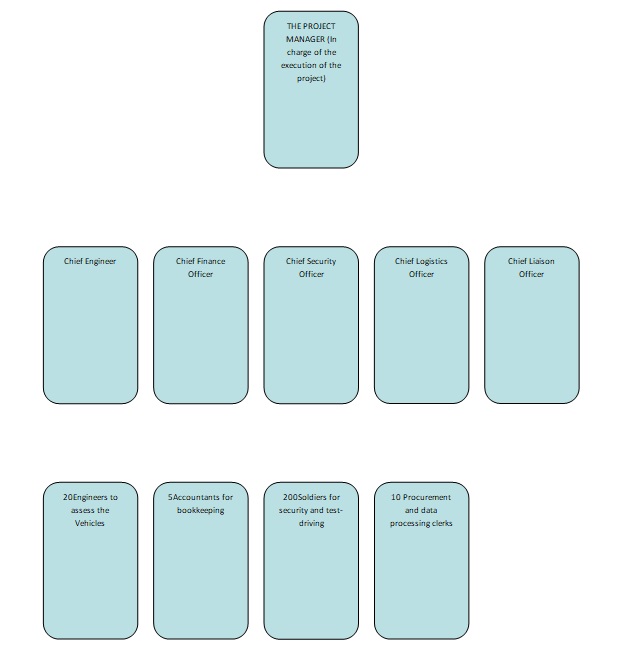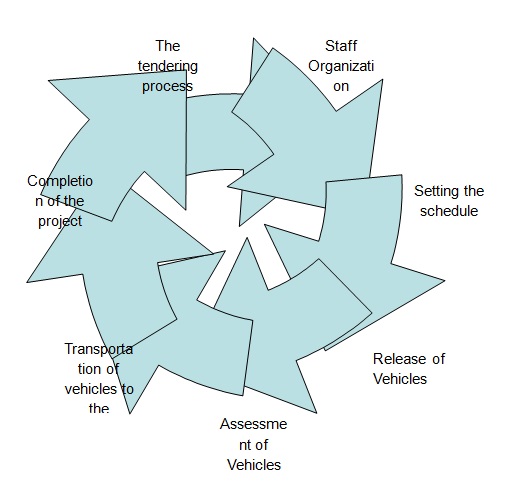Introduction
The following is a project organization for the Australian Defence Forces in their attempt to modernize their military equipment to match and exceed the existing military technologies to better the welfare and the defense of Australian countries. The project is multi-phase named Project LAND 121 and this Project Management plan is based on phase three where the Australian Defence Forces plan to acquire 2,146 unprotected light G-Wagon vehicles, 1799 lightweight trailers, 293 Bushmasters, and Medium/Heavy vehicles. These are meant to upgrade the Australian defense forces’ capability in protecting the nation and providing reinforcements whenever needed.
External Interface
The following is a description of the parts of the external interfaces of the project. The external interfaces are those parts of the project handled by other forces outside the scope of the project manager although they are part of the project. The following is a description of how the project is organized and who will be responsible for each phase of the project. The first phase is the initiation phase where the project starts with the process of planning and bringing qualified people to manage each part of the project. This initiation begins with the process of tendering the project so that the company to manufacture the vehicle can be used. The minister indicates that the tendering process for the manufacturing process is over.
The other major part of this project is that of the implementation of the project. The implementations will involve ensuring that there are sufficient funds for the acquisition and procurement of these vehicles. The government of Australia through the Australian Defence Forces will provide the funds (Becker 2003).
Internal Interface
This internal interface is about the process and phases within the project, which are within the scope of the project management. This regards the internal structure and organization of the project. The internal interfaces of this project are concerned with quality control and timely delivery of the heavy and medium-size vehicles. It is worthwhile noting that there are several types of medium size vehicles and the project will involve determining the number of vehicles to be delivered for each type. The first internal phase of this project will look into the organization of the people involved in making the project successful. The structure involves the people in the project such that they are working under the project manager to facilitate and enhance the success of this project.
The project manager
This project shall have a project manager whose sole responsibility is to ensure the final delivery of the 2700 heavy and medium-weight trucks to the Australian defense forces. The project manager is the overall head of this project and his major responsibility is to make the project successful.
The Scope of Authority
The project manager is responsible for the endeavor of this project. This project is involved with quality assurance of the vehicles to ensure that the vehicles delivered by the manufacturing company are in good condition and they have met the specifications that were in the tender. The project manager is also the major link between the government and Rheinmetall Defence of the company responsible for the manufacture of the vehicles. This means that the project manager is the bridge between the two entities, as the government will seek any clarification from the project manager. Likewise, the manufacturing company will enquire from the project manager for any issue in need of clarification. The project manager is also the leader of the project team especially his subordinates who will rely on him for guidance and detailed instructions.
Organization Chart

Scope of responsibility
Five Chief Officers who report directly to him assist him. The chief officers are the chief engineer, chief finance officer, chief logistic officer, and the liaison and communication officer. The project manager will have a chief engineer who will be in charge of quality control. This involves assessing the quality of each vehicle to ensure that it meets the set standards. The chief engineer will work with another group of twenty engineers to complete the work within a reasonable time.
The project will have a chief financial officer whose major work is to source the necessary funds needed in this project from the ministry of defense and the Australian Defence forces. Five accountants will assist the financial officer and their major work is to ensure accountability in the funds provided by the government. To ensure that there is a smooth flow of funds from the ministry, the project will have a chief Liaison Officer whose major work is to liaise with the government and to ensure proper flow of information, which regards the needed funds in the project. Communication is a major aspect of this project. The liaison officer shall be in charge of communicating and briefing both the ministry and the public about the extent of the project and the progress made in implementing the project.
Due to the movement logistics, involving secure delivery of the vehicle to the barracks there will be a chief logistics officer to ensure that there is a smooth flow of the vehicles to the barracks. Forty soldiers will assist the logistics officer. This is a national security issue requiring privacy and there will be chief security officers who will co-work with the logistics officer to ensure that the project is secure and done privately away from potential enemies. The intelligence chief security officer will command twenty paramilitary officers or any other Australian Defence Forces required in keeping the project secure. Also, there will be an office manager in charge of office operations and maintenance. Finally, the project will incorporate a chief accountant to maintain the financial statement for the project and to audit the project once it is completed (Lewis 2000).
Internal responsibilities
The following is a chart indicating the internal responsibilities in the project organization and those who are responsible for the execution of those responsibilities:

The internal responsibilities are those activities that are part of the project organization. The first internal activity is that of supervision of workers in the project management. The project manager is the one who is to ensure that the entire departments are utilizing the human resource to the maximum. These responsibilities are internal and fall directly under the project manager who can delegate it to the assistants who are responsible for the supervision of their subordinates.
The second internal responsibility is that of validation and assessment of the vehicles from the manufacturer. This is a very important responsibility of the project organization. The chief engineer is the one who will be responsible for quality validation and the necessary assessment tasks of the vehicles such as test driving and quality control. To ensure success a minimum of twenty engineers will work under the chief engineer.
The other important internal responsibility concerns the issue of financial management that is very critical in this project. The Chief Finance Officer will oversee the flow of finances in the project especially finances that deal with salary payments, purchase of materials, and balancing of the books of account. The finance officer will receive assistance from twenty accountants who will report directly to him.
Communication is another major internal responsibility. This is because the project organizer or the project manager acts as a link between the government and the Rheinmetall who is the manufacturer of the defense vehicles. The communication will involve ensuring the proper flow of information from the government to the manufacturer as well as the proper flow of information from the project manager to the workers. Communication done through emails and the work of the liaison officer will be of preparing memos and letters as instructed by the project manager.
External Responsibilities
The following is a chart indicating the external responsibilities involved in the organization of this project and the individuals responsible for those activities.

The external responsibilities involve several activities. The first one is that of securing the vehicles manufactured. As vehicles intended for the defense force need security even during the manufacturing process. The project manager will therefore accord security to the manufacturer. This will be the responsibility of the chief security officer. Transportation of these vehicles is a major logistic issue and it will require proper mechanisms layout to ensure that the vehicles have moved from the manufacturer to the right destination within the stipulated time. Scheduling is another major aspect of the work taken into consideration.
Project roles and responsibilities

The first responsibility is identifying the contractor through tendering (Becker 2003). The government is responsible for issuing tender through the ministry of defense. This part of the project is already complete. The second will be having a team and all the staff needed in the project by the end of the month. The staff selection is the responsibility of the project manager in conjunction with the ministry officials who will ensure that competent staffs handle the various aspects of this project.
After the staffs are in place, we shall await the release of funds from Treasury for one month. After the release of funds to both the project manager and the contractor, the contractor will first deliver the 700 medium mobility truck within the first four months after which our team will take a month to assess and approve the quality of the vehicles. In the second phase, the contractor will avail of 1000 HX series vehicles within four months. The assessing team will take a month to assess the quality and capabilities of the vehicle for approval. The contractor will again deliver 500 High Mobility Trucks within three months. Our assessing engineers will take one month to complete the assessments. The safe High Mobility Cabin Vehicles will also take four months to be manufactured and one month of validation and quality control of the vehicles. The following is the schedule of the delivery of vehicles:
Delivery Schedule from the manufacturer.
After the process of assessment is over, the next responsibility will involve ensuring safe transportation of the vehicles to the desired destination and scrutiny by ministry officials so that they may consider the project as complete. This will fall into the hands of the logistics officer who will work in collaboration with the security officer to ensure that the assessed vehicles are not tampered with until the ministry official receives them officially and hands them over to the Australia Defence Forces (Harold 2003).
Conclusion
This mega project will assert the place of Australia as one of the powerful countries in the world in terms of military strengths. The organization of this project is important for the success of this project as planning is important in its implementation and bringing together the needed resources for its completion. This project needs adoption with immediate effect.
References
Becker, M 2003, Process management: A guide for the design of business processes, Oxford University Press, New York.
Harold, K 2003, Project management: A systems approach to planning, scheduling, and controlling, Wiley, London.
Lewis, J (2000). The project manager’s desk reference: A comprehensive guide to project planning, scheduling, evaluation, and systems, Harvard Business Review, Massachusetts.